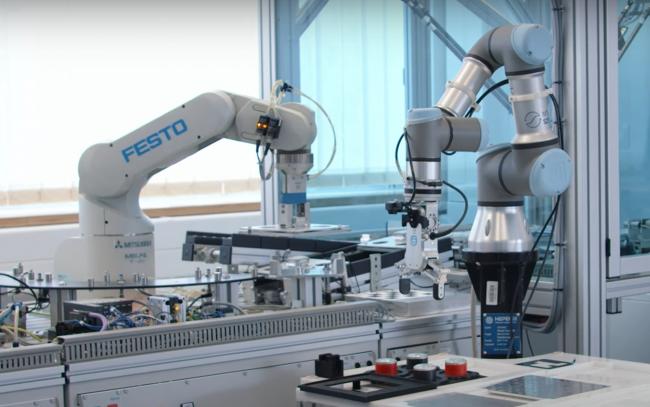Manufacturing Execution System as a Service (MESS) – video of SZTAKI's demonstration in Győr
The manufacturing Execution Systems (MES) are abandoning their traditional role of legacy executing middle-ware. They are targeting the much wider objective of functional interoperability among autonomous, distributed and collaborative Cyber-Physical Systems (CPS).
In this video we present the Manufacturing Execution System as a Service (MESS) realized by the EMI Laboratory at SZTAKI, which provides a basic (yet effective) methodology and a tool for universally modeling, digitalizing and integrating the services offered by a variety of isolated workcells into a single, standardized and augmented production system.
The aim was to simplify every intelligent and decision-making aspects of a MES, in order to create a "minimalistic" nervous system for manufacturing, which connects both low-level resources and their operations together, and furthermore links them to the high-level orchestrators (like a scheduler or an Enterprise Resource Planner - ERP).
The result was a reliable, reconfigurable and interoperable manufacturing architecture which privileges Open Platform Communications Unified Architecture (OPC UA) and its rich possibilities for information modeling at a higher level of the common service interoperability, along with Message Queuing Telemetry Transport (MQTT) lightweight protocols at lower levels of data exchange.
The types of CPS utilized in this work comprise a variety of elements, like single robot arms, production assembly lines, Automated Guided Vehicle (AGV) fleet (with and without robot arms), collaborative robots and human operated components, such as the warehouse and a digital work assistance system. The functions of a CPS are organized and linked together in a (graph-like) process plan by means of precedence edges, which represent the necessary conditions for the specific CPS function to execute. In the video we demonstrate the use of MESS for the assembly of termometers in one of our premises. As one can see, mobile robots do not have to dock perfectly (and so mechanical docking utilities are not needed) as robotic arms can manipulate the workpieces using computer vision based 3D reconstruction and markers.
The MESS presented in the video has been realized within the framework of the GINOP-2.3.2-15-2016-00002 granton an "I4.0 research and innovation center of excellence" and by the ED_18-2-2018-0006 grant on a "Research on prime exploitation of the potential provided by the industrial digitalisation". The system has been demonstrated and validated in several production use-cases at the research manufacturing laboratory of excellence for industrial testbeds in Győr.
